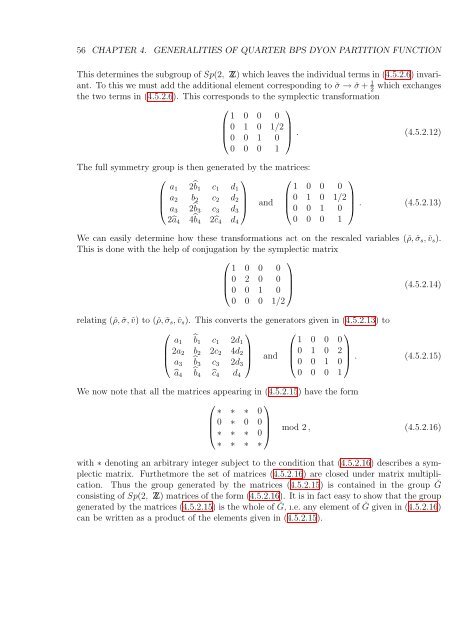PHYS08200604018 Shamik Banerjee - Homi Bhabha National ...
PHYS08200604018 Shamik Banerjee - Homi Bhabha National ...
PHYS08200604018 Shamik Banerjee - Homi Bhabha National ...
You also want an ePaper? Increase the reach of your titles
YUMPU automatically turns print PDFs into web optimized ePapers that Google loves.
56 CHAPTER 4. GENERALITIES OF QUARTER BPS DYON PARTITION FUNCTION<br />
This determines the subgroup of Sp(2, Z) which leaves the individual terms in (4.5.2.6) invariant.<br />
To this we must add the additional element corresponding to ˇσ → ˇσ + 1 which exchanges<br />
2<br />
the two terms in (4.5.2.6). This corresponds to the symplectic transformation<br />
⎛<br />
⎞<br />
1 0 0 0<br />
⎜ 0 1 0 1/2<br />
⎟<br />
⎝ 0 0 1 0 ⎠ . (4.5.2.12)<br />
0 0 0 1<br />
The full symmetry group is then generated by the matrices:<br />
⎛<br />
⎞ ⎛<br />
⎞<br />
a 1 2̂b 1 c 1 d 1<br />
1 0 0 0<br />
⎜ a 2 b 2 c 2 d 2<br />
⎟<br />
⎝ a 3 2̂b 3 c 3 d 3<br />
⎠ and ⎜ 0 1 0 1/2<br />
⎟<br />
⎝ 0 0 1 0 ⎠ . (4.5.2.13)<br />
2â 4 4̂b 4 2ĉ 4 d 4 0 0 0 1<br />
We can easily determine how these transformations act on the rescaled variables (ˇρ, ˇσ s , ˇv s ).<br />
This is done with the help of conjugation by the symplectic matrix<br />
⎛<br />
⎞<br />
1 0 0 0<br />
⎜ 0 2 0 0<br />
⎟<br />
⎝ 0 0 1 0 ⎠ (4.5.2.14)<br />
0 0 0 1/2<br />
relating (ˇρ, ˇσ, ˇv) to (ˇρ, ˇσ s , ˇv s ). This converts the generators given in (4.5.2.13) to<br />
⎛<br />
⎞ ⎛<br />
⎞<br />
a 1<br />
̂b1 c 1 2d 1<br />
1 0 0 0<br />
⎜ 2a 2 b 2 2c 2 4d 2<br />
⎟<br />
⎝ a 3<br />
̂b3 c 3 2d 3<br />
⎠ and ⎜ 0 1 0 2<br />
⎟<br />
⎝ 0 0 1 0 ⎠ . (4.5.2.15)<br />
â 4<br />
̂b4 ĉ 4 d 4 0 0 0 1<br />
We now note that all the matrices appearing in (4.5.2.15) have the form<br />
⎛<br />
⎞<br />
∗ ∗ ∗ 0<br />
⎜ 0 ∗ 0 0<br />
⎟<br />
⎝ ∗ ∗ ∗ 0 ⎠ mod 2 , (4.5.2.16)<br />
∗ ∗ ∗ ∗<br />
with ∗ denoting an arbitrary integer subject to the condition that (4.5.2.16) describes a symplectic<br />
matrix. Furthetmore the set of matrices (4.5.2.16) are closed under matrix multiplication.<br />
Thus the group generated by the matrices (4.5.2.15) is contained in the group Ǧ<br />
consisting of Sp(2, Z) matrices of the form (4.5.2.16). It is in fact easy to show that the group<br />
generated by the matrices (4.5.2.15) is the whole of Ǧ, ı.e. any element of Ǧ given in (4.5.2.16)<br />
can be written as a product of the elements given in (4.5.2.15).

















